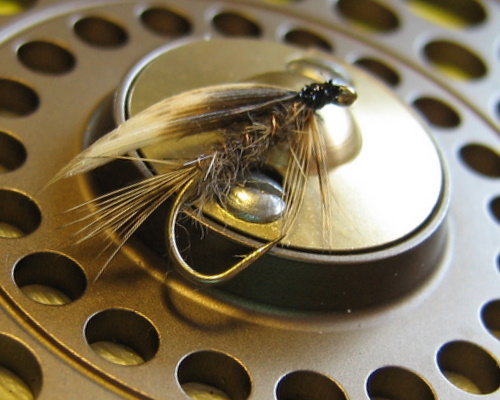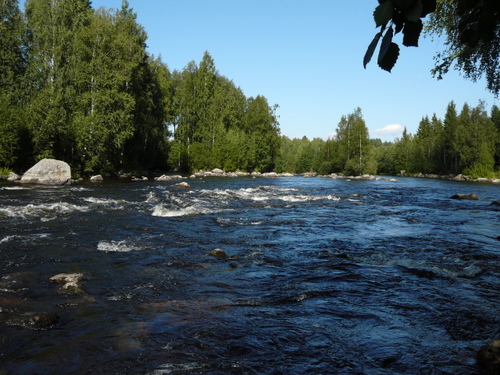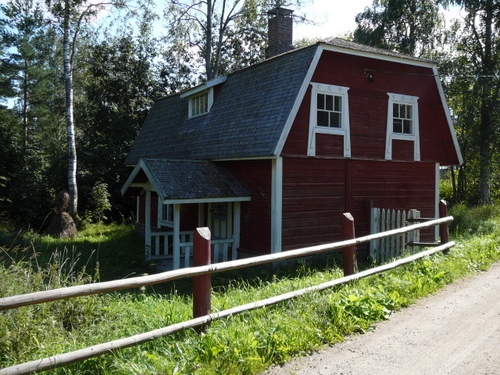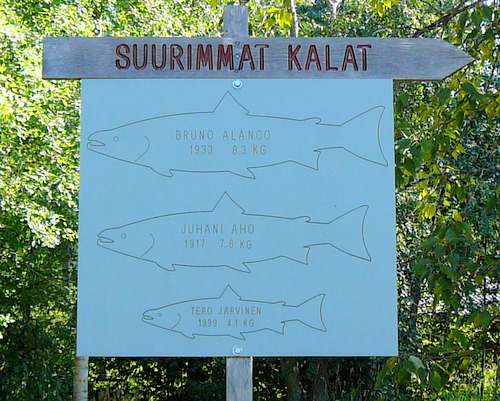
About a month ago I tied a few March Browns, winged wet flies dating back a long time. In the 80s I was with my parents fishing the Ruunaa Rapids in Eastern Finland. I had a fly rod and had bought, or at least whined to my parents long enough that they had bought me, a package of of three wets, pretied in a leader. I remember the horrible mess the rig was after a few minutes of serious rod waving. One of the flies was a March Brown Silver. I caught couple of fish. They were bleak, no trout for me back then, thank you.
I intented to visit the Ruunaa again last August but instead decided to go to the very heart of Finnish brown trout fly-fishing tradition, the Huopana. It is not a big river, or at least long, only about 1.2 km or .75 miles.

But its every pool and channel has been named and there are even rocks that have names. Those rocks are named after fishermen. That is what I call tradition.

The whole milieu of the river is unique. The houses, the old bridge, and even the old hydroelectricity plant just belongs there. As well as the fishermen (no more than 10 per day with the current regulations) and the brown trout.

The all time sport tackle record trout from Huopana was landed by Mr. Bruno Alanko on 22nd of August 1933 using "a yellow fly". That was 8.3 kilograms or 18.5 pounds of lake-run brown trout.
I visited the river exactly 74-years later. After a short but good night sleep in my car I saw two fly fishermen with a story to tell. "I just lost the trout of my life" was the first thing the younger man said to me when we met. With wide eyes and stunned expression on his face he told me about the trout he hooked and played for good thirty minutes. The hands of the older man were wide apart when he estimated the size of the fish with his hands. At least 5 kilograms he said. The fish broke of just when they thought that they could finally land him.
The tradition of fly-fishing is not static. It lives and evolves as we read, write, talk, and dream about it.
9 comments:
That's good stuff, Olli. Great looking fly and some real old timey Fin fly fishing heritage.
That winged march brown got me thinking about our upcoming fly swap.
Wyatt
Thanks Wyatt. I think the march brown needs one or two more coats of black varnish. The head is messy.
I have some time to tie flies right now, so I could start tying your flies right now.
Opax (Olli),
You ever come to the states to fish? Great stuff on tradition..... us young bucks need to recognize.
-SJ
Sir Jackson, I haven't but I will. Thanks for the comment.
Nice post. I spent this last year learning the traditions of yorkshire and clyde-style wet fly fishing to the exclusion of dries and nymphs and I have learnt a great deal.
It is certainly worth going back in time and studying what anglers like T E Pritt and W C Stewart said, re-tracing the wisdom that took them years to acquire.
http://www.streamthought.org/journal/
Hi flyfishertc,
The early fly fishing for trout in Finland was very much influenced by the merchants and aristocrats of the British Empire. First flies were Salmon Flies or Winged Wet Flies.
Great read, It is really unfortunate that the tradition of the past are not being followed by the newer generations.
There are some older methods and Flies that are still GREAT, I use some of the old patterns as part of my Fly arsenal as much as I can.
Rick Passek
It is rather interesting for me to read this article. Thank you for it. I like such topics and anything that is connected to them. I would like to read a bit more soon.
Sincerely yours
Alice Tudes
Bookmarked! This is really interesting, You're a very skilled blogger. Thanks for sharing this amazing kind of post.
Post a Comment